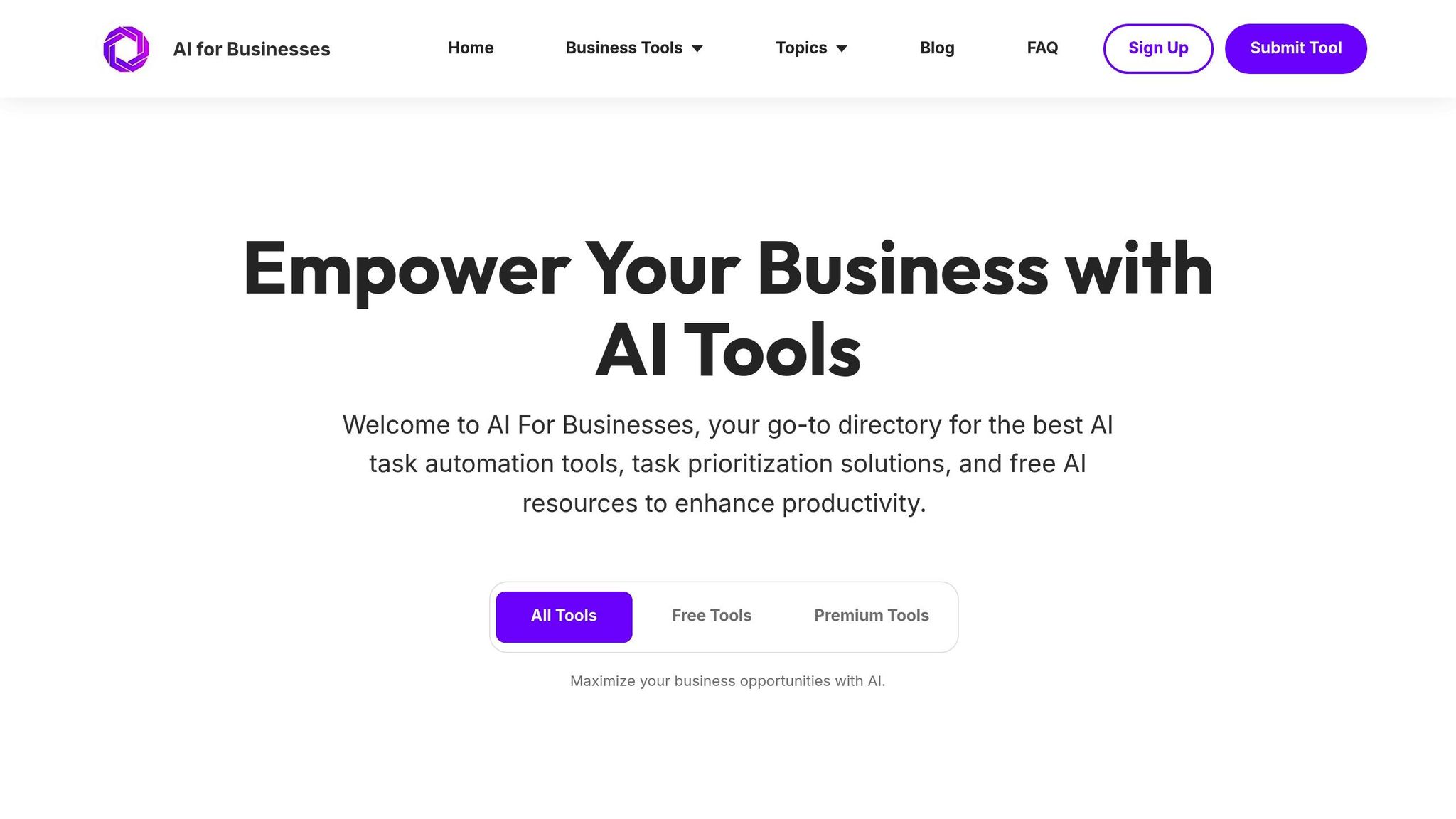AI is helping small and medium-sized enterprises (SMEs) save money and work smarter. By automating repetitive tasks, reducing errors, and improving efficiency, AI tools make it easier for SMEs to handle customer service, marketing, back-office tasks, and HR processes without breaking the bank.
Here’s what you need to know:
- Customer Service: AI chatbots reduce labor costs by handling routine inquiries 24/7, improving response times and customer satisfaction.
- Marketing and Sales: AI tools predict customer churn, generate better leads, and optimize campaigns, helping SMEs get more value out of their budgets.
- Back-Office Tasks: AI automates payroll, invoice processing, and compliance tasks, cutting errors and saving time.
- HR and Workflow: AI simplifies hiring, onboarding, and scheduling, allowing HR teams to focus on employee growth.
AI tools are now affordable and easy to use, making them accessible to businesses of all sizes. Platforms like "AI for Businesses" offer curated solutions tailored to SME needs, ensuring a strong return on investment. SMEs can now compete effectively while keeping expenses low.
AI ROI for Small Businesses - How SMEs Gain Faster Returns than Big Enterprises
Case Study: AI Customer Support Automation
Customer support is often one of the biggest expenses for small and medium-sized enterprises (SMEs), with staffing and training costs quickly adding up. But AI-powered chatbots and virtual assistants are shaking things up, offering smaller businesses an affordable way to deliver excellent customer service while keeping costs under control.
Cutting Labor Costs with AI Chatbots
AI chatbots can make a noticeable dent in labor costs. Traditional customer support models require multiple agents and carefully planned schedules to ensure round-the-clock service, which can be expensive. In contrast, AI chatbots operate 24/7 and can handle a large number of routine inquiries, reducing the need for a big team of human agents.
By deploying AI chatbots, businesses can immediately lower expenses by replacing costly full-time staff. These systems are also highly scalable - while hiring more agents means higher costs, a single chatbot can handle multiple conversations at once without driving up expenses.
Another major advantage is consistency. Human agents can vary in their responses, which sometimes frustrates customers. AI chatbots, on the other hand, provide reliable, protocol-driven answers, minimizing miscommunication. They excel at managing routine tasks like checking order statuses, answering basic product questions, and resolving simple issues. This frees up human agents to focus on more complex problems that require empathy and expertise.
These efficiencies not only lower labor costs but also lead to quicker improvements in customer satisfaction.
Better Customer Satisfaction and Response Times
AI chatbots don’t just save money - they also elevate the customer experience by delivering faster and more tailored service. Their ability to respond instantly to inquiries sets a new standard in customer support. Plus, many chatbots come with multilingual capabilities, making it easier for businesses to expand their reach without hiring additional staff.
Another benefit? AI chatbots can analyze customer interactions to uncover common concerns and questions. This data helps SMEs identify recurring issues, refine their products, and improve their support systems - all without the need for costly market research. Faster response times compared to traditional methods also mean happier customers and stronger loyalty.
What’s more, these systems get better over time. They learn from customer feedback, reducing the need for constant retraining. When integrated with existing platforms, chatbots can access real-time customer data, order histories, and product details. This allows them to provide responses that are not only fast but also highly personalized - something human agents might struggle to deliver when juggling multiple tools.
Case Study: AI in Marketing and Sales
Marketing and sales can be a huge drain on the budgets of small and medium-sized enterprises (SMEs), especially when traditional campaigns rely on broad targeting and gut instincts. AI is changing the game by offering more precise marketing tools and efficient sales strategies, giving SMEs a chance to compete with larger companies. Let’s look at two examples where AI has delivered real cost savings.
AI for Predicting Customer Churn
Keeping existing customers is almost always cheaper than finding new ones. That’s where AI-powered churn prediction tools come in. These tools analyze customer behavior, purchase history, and engagement patterns to spot early signs of potential churn. For example, one SME used an AI solution to track usage trends and support interactions. This allowed the company to identify customers at risk of leaving and reach out with personalized retention strategies. The result? Better customer retention and smarter resource allocation, focusing efforts where they mattered most.
Better Lead Generation with AI
Traditional lead generation can feel like throwing darts in the dark. AI changes that by analyzing massive datasets to find high-quality leads. It looks at factors like company size, recent hiring activity, and engagement patterns to identify prospects with a higher chance of converting. On top of that, AI enhances email personalization, adjusts campaign timing dynamically, and fine-tunes social media targeting. Over time, the system learns and improves, making marketing efforts more precise and effective with every iteration. This smarter targeting helps SMEs get the most out of their marketing budgets.
Case Study: AI Business Process Automation
For small and medium-sized enterprises (SMEs), back-office tasks like invoice processing, payroll, and procurement can eat up valuable time and are prone to errors. Enter AI and robotic process automation (RPA). These technologies are reshaping how businesses handle repetitive administrative work, freeing up employees to tackle more strategic priorities. Let’s explore how automating these routine tasks can lead to major cost savings and improved efficiency.
Automating Back-Office Functions
AI automation has become a game-changer for SMEs, especially in finance departments. Take invoice processing, for example: AI-powered systems can scan invoices, extract key details, and seamlessly input the data into accounting software. Similarly, payroll tasks are simplified - AI tools can pull data from timesheets, calculate paychecks, and handle tax withholdings automatically. Procurement processes, such as tracking orders, comparing vendor quotes, and managing approvals, also benefit from this streamlined approach.
Beyond these tasks, AI systems can analyze spending patterns to uncover ways to save money and flag unusual purchases for further review. This level of automation not only slashes operational costs but also reduces the likelihood of compliance missteps, making daily operations smoother and more reliable.
Reducing Errors and Compliance Costs
Mistakes in administrative tasks can be expensive. A payroll error might trigger tax compliance issues, while an oversight in invoice processing could lead to duplicate payments or missed discounts. Automating these processes with AI significantly lowers error rates, ensuring data accuracy and avoiding the ripple effects of costly mistakes.
AI also plays a crucial role in helping SMEs stay compliant with ever-changing regulations. Tax reporting, employee benefits, and other legal requirements are areas where businesses often struggle to keep up. AI systems can automatically update to reflect new rules, reducing the risk of penalties and minimizing the need for expensive legal consultations.
Another bonus? AI creates a built-in audit trail. Every action is logged and timestamped, making it far easier to demonstrate compliance during audits. This level of documentation, often hard to achieve manually, becomes effortless with automation.
In short, SMEs that embrace AI-driven business process automation often see measurable improvements in efficiency, cost savings, and compliance management. It’s not just about saving time - it’s about running smarter.
sbb-itb-bec6a7e
Case Study: AI for HR and Workflow Efficiency
Small and medium-sized enterprises (SMEs) often face a juggling act in their HR departments. Limited staff and budgets make it challenging to manage tasks like screening resumes or coordinating employee schedules. Fortunately, AI is reshaping workforce management by automating time-consuming processes, saving both time and money.
Automating Hiring and Onboarding
The hiring process is notorious for being resource-intensive. From posting job ads to onboarding new hires, the traditional approach can drain HR teams. AI recruitment tools, however, simplify these tasks by automating job postings, resume screenings, interview scheduling, and onboarding activities. This reduces the workload and speeds up the process significantly.
Take resume screening, for example. For small HR teams, sorting through applications can be overwhelming. AI tools can quickly sift through large volumes of resumes, identifying candidates who meet specific qualifications and experience levels. These tools also evaluate skills and experience, even assessing how well a candidate might align with the company’s culture.
When it comes to interview scheduling, AI assistants make life easier by coordinating calendars, sending reminders, and rescheduling when conflicts arise. Some systems even integrate video conferencing, automating the entire scheduling process.
Onboarding automation is another game-changer. AI can create personalized welcome packets, assign role-specific training modules, and track new hires’ progress. Digital workflows guide employees through completing paperwork and ensure compliance with necessary regulations.
The result? Faster hiring cycles, reduced costs, and a better experience for candidates. This improved process often leads to higher job offer acceptance rates and lower early turnover. With these tasks automated, HR teams can focus on what really matters - helping employees grow and thrive.
Better Scheduling and Workflow Management
AI isn’t just transforming hiring; it’s also revolutionizing scheduling and workflow management. Predictive scheduling uses historical data, seasonal trends, and business forecasts to optimize staffing while keeping costs under control.
For businesses with fluctuating demand, AI scheduling tools are invaluable. They balance employee availability, skill sets, labor laws, and overtime limits to create efficient schedules. When adjustments are needed, these tools quickly suggest cost-effective solutions.
Beyond scheduling, workflow optimization identifies bottlenecks, streamlines processes, and makes project timelines more predictable. AI-driven tools provide realistic resource plans, ensuring smoother operations.
Productivity tracking is another area where AI shines. These tools help managers understand work patterns without micromanaging. They can identify peak productivity times, recommend optimal break schedules, and even flag potential burnout risks. This data-driven insight can lead to happier employees and reduced turnover costs.
AI also simplifies compliance management by monitoring labor laws, overtime rules, and break schedules. It ensures accurate record-keeping for audits and minimizes the risk of legal violations.
Using AI Tools with AI for Businesses

After exploring how AI can help cut costs, the next step is choosing the right tools. For small and medium-sized businesses (SMEs), this can feel like navigating a maze. With so many options out there, figuring out which tools will actually save money and improve operations can be a real challenge. That’s where a curated resource comes in handy - something that connects the dots between specific SME challenges and the right AI solutions.
Curated AI Tools for SME Needs
AI for Businesses is a platform designed to simplify this process. It offers a carefully curated directory of AI tools tailored to help SMEs save money and streamline operations. Instead of spending hours researching and comparing solutions, business owners can find a trusted collection of tools all in one place.
The directory includes a variety of AI tools aimed at solving common SME pain points. For example:
- Looka: Helps businesses create professional logos and branding without the high costs of hiring a design agency.
- Rezi: Simplifies resume screening, improving HR efficiency.
- Stability.ai: Provides advanced image generation for marketing materials.
- Writesonic: Automates content creation for websites, emails, and social media campaigns.
What makes this platform stand out is its focus on real-world business needs rather than experimental or overly complex technologies. Each tool in the directory is vetted for its ability to deliver tangible results for businesses with limited budgets and technical expertise.
The platform offers flexible pricing plans, starting with a free Basic option and going up to a Pro plan at $29/month. For larger businesses with unique needs, custom Enterprise plans are also available. This structure ensures that businesses of all sizes can find tools that align with their goals and resources.
Matching AI Tools to Business Goals
To truly cut costs and improve efficiency, it’s important to align specific business challenges with the right AI tools. The AI for Businesses directory makes this easy by helping SMEs identify solutions that directly address their operational bottlenecks and cost concerns.
Drawing from earlier examples, SMEs can use tools like Looka for branding, Rezi for HR, Stability.ai for creating marketing visuals, and Writesonic for automating content creation. This approach allows businesses to build an AI stack that works cohesively, tackling their most pressing challenges head-on.
The platform encourages business owners to think strategically about AI adoption. Instead of randomly picking tools, they can create a well-rounded tech stack that aligns with their financial and operational goals. This way, AI investments are more likely to deliver measurable returns without adding unnecessary complexity.
For instance, a restaurant might focus on scheduling optimization tools to manage staff more efficiently, while a consulting firm might prioritize tools for automating proposals and client communication. By matching tools to specific pain points, businesses can maximize the impact of their AI investments while keeping costs and learning curves manageable.
Conclusion: AI Cost Savings for SMEs
The case studies we've explored highlight how AI can reshape everyday operations for small and medium-sized enterprises (SMEs), offering measurable cost savings and boosting efficiency. It's clear that AI isn't just a futuristic concept - it's a practical tool that helps SMEs cut costs and streamline workflows. These real-world examples show how AI can deliver a strong return on investment.
Key Takeaways from the Case Studies
From customer support to marketing, back-office tasks, and HR management, AI has proven its ability to reduce costs by automating repetitive processes and enhancing accuracy. One standout lesson from these examples is that SMEs can achieve the kind of efficiency typically associated with larger enterprises, all while avoiding the heavy costs and complexities that often come with traditional solutions.
The ROI of AI for SMEs
The return on investment for AI is often realized quickly. Many SMEs report noticeable savings in critical areas of their operations. What makes AI particularly appealing is its accessibility - there’s no need for hefty upfront investments or advanced technical expertise. Many tools, like those offered through platforms such as AI for Businesses, are designed specifically for SMEs, making deployment quick and straightforward.
For SMEs considering AI, the combination of cost savings and improved performance makes it an obvious choice for sustainable growth. With affordable pricing and user-friendly platforms now widely available, adopting AI has never been easier. By integrating AI into their operations, SMEs can not only cut costs today but also position themselves to compete and thrive in an ever-evolving market.
FAQs
How do AI chatbots help SMEs improve customer satisfaction while cutting costs?
AI chatbots are transforming how small and medium-sized enterprises (SMEs) handle customer service. By providing 24/7 support, delivering quicker responses, and managing multiple inquiries simultaneously, chatbots create a smoother and more efficient experience for customers. This not only boosts satisfaction but also helps build stronger customer loyalty.
On top of that, chatbots help businesses cut costs by automating routine tasks like answering FAQs or resolving straightforward issues. In fact, companies can save up to 30% or more on operational expenses. These savings free up resources that can be used to address more complex customer needs. The combination of improved service and reduced costs makes AI chatbots an essential tool for SMEs aiming to streamline their customer service efforts.
What are some examples of AI tools that help small businesses improve their marketing and sales efforts?
AI tools have become a game-changer for small businesses looking to sharpen their marketing and sales strategies. By automating repetitive tasks and streamlining workflows, these tools help businesses work smarter, not harder. Take HubSpot, for instance - it uses AI to personalize email campaigns and fine-tune send times, ensuring businesses connect with their audience when it matters most.
Then there’s Koala AI, which simplifies the process of crafting long-form marketing content. This makes it easier to create engaging material that resonates with potential customers.
On the operational side, tools like Consensus and Zoho People handle tasks like contact management, personalized outreach, and internal team coordination. These solutions not only save valuable time but also enhance overall productivity, giving small businesses the freedom to focus on what really matters: building meaningful customer relationships and driving growth.
How can AI help small businesses save money by automating back-office tasks?
AI is a game-changer for small businesses, especially when it comes to cutting costs. By automating repetitive back-office tasks - like invoicing, scheduling, and customer service - AI not only speeds up processes but also minimizes manual errors and enhances decision-making.
Research highlights just how impactful automation can be. For instance, it can slash processing costs by 30–50%, trim overhead expenses by around 9%, and dramatically reduce labor costs. With streamlined operations, small and medium-sized enterprises (SMEs) can redirect their resources toward growth-oriented initiatives, making their efforts more efficient and focused.


